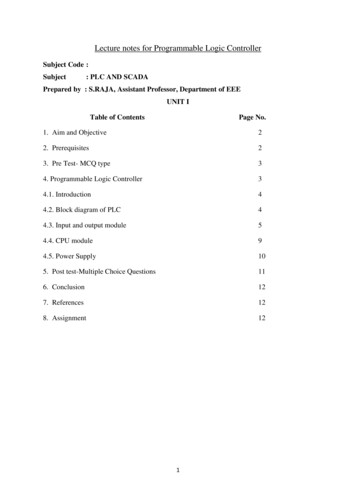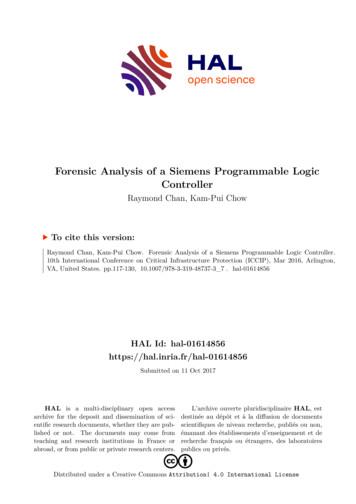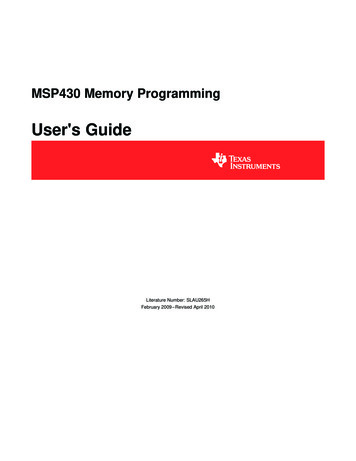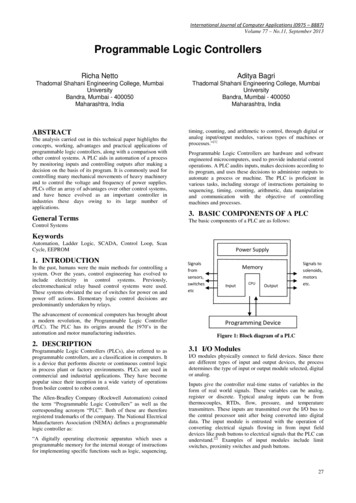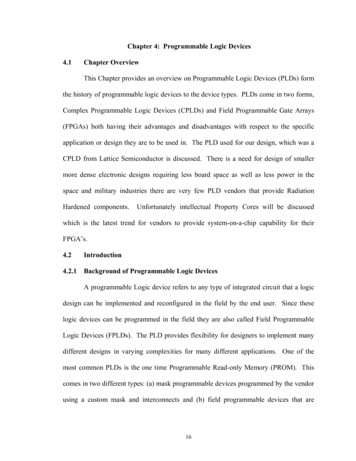
Transcription
Lecture 13: Memory andProgrammable LogicSyed M. Mahmud, Ph.DECE DepartmentWayne State UniversityAby K George, ECE Department, Wayne State University
Contents Introduction Random Access Memory Memory Decoding Read Only Memory Programmable Logic Array Programmable Array Logic Sequential Programmable DevicesChapter 7ECE 2610 – Digital Logic 12
Introduction Memory unit: A device to which binary information is stored, and fromwhich information is retrieved when needed for processing. Two types of Memories Random Access Memory (RAM) Read Only Memory (ROM) RAM can perform read and write operations ROM is a programmable logic device (PLD) Other types of PLDs Programmable Logic Array (PLA) Programmable Array Logic (PAL) Field Programmable Gate Array (FPGA)Chapter 7ECE 2610 – Digital Logic 13
Random Access Memory (RAM) Information can be selectivelyretrieved from any of itsinternal location (any randomlocation). Binary information is stored ingroups of words. For 𝑘 address lines, 2𝑘 wordsare possible. 1 byte 8 bitsChapter 7ECE 2610 – Digital Logic 14
Random Access Memory (RAM) The address line select one particularword. Each word in memory is assigned anidentification number called address.For 𝑘 address lines the address will befrom 0 to 2𝑘 1.1 byte (B) 8 bits (b)1 Kilobyte (K / KB) 210 bytes 1,024 bytes1 Megabyte (M / MB) 220 bytes1 Gigabyte (G / GB) 230 bytes1 Terabyte (T / TB) 240 bytes1K X 16 MemoryChapter 7ECE 2610 – Digital Logic 15
Write and Read Operations in RAM Write operation Apply the binary address ofthe desired word to theaddress lines. Apply the data bits thatmust be stored in memoryto the data input lines. Activate the write input. Read Operation Apply the binary address ofthe desired word to theaddress lines. Activate the read input.Chapter 7ECE 2610 – Digital Logic 16
Types of RAMs Static RAM (SRAM) Consists of internal latches. Information is available as long as the power is applied. Have shorter read/write cycles. Dynamic RAM (DRAM) Stores information in the form of electric charges on capacitors. Stored charge in capacitor tends to discharge with time, and the capacitorsmust be periodically recharged by refreshing the dynamic memory. Reduced power consumption and larger storage capacity.Chapter 7ECE 2610 – Digital Logic 17
RAM – Memory Cell Binary cell is modeled by an SR Latch with associated gates to form DLatch. The Binary cell stores 1-bit data.Chapter 7ECE 2610 – Digital Logic 18
Design of a 4 x 4 RAM 4 – Address Lines 4 – Outputs2𝑚 𝑛 RAM consists of𝑚 2𝑚 decoder, 𝑛 inputlines and n output linesChapter 7ECE 2610 – Digital Logic 19
Decoder for RAM 𝑘 inputs - 2𝑘 outputs 2𝑘 - AND gates with k inputs The total number of gatesand the number of inputsper gate can be reduced byusing two decoders in atwo-dimensional selectionscheme. 10 X 1024 decoder usingtwo 5 X 32 decoders.Chapter 7ECE 2610 – Digital Logic 110
Read Only Memory (ROM) Permanent storage ofbinary information. 5 x 32 Decoder8-OR gates with 32 inputs for each256 internal connectionsConnections are programmableSimplest way is to use fuses.High Voltage is applied to blown thefuse.Chapter 7ECE 2610 – Digital Logic 111
Read Only MemoryChapter 7ECE 2610 – Digital Logic 112
Combinational Circuit Implementation inROM 𝐹1 Σ 0,1,2,4,7 𝐹2 Σ(1,2,4,6,7)Chapter 7ECE 2610 – Digital Logic 113
Types of ROMs Paths in ROM can be programmed in four ways Mask Programming Done during fabrication. Costly method and useful when large quantity of the same ROM is required. Programmable Read Only Memory (PROM) Fuses are blown by high voltage pulses. PROM is programmable in the library. Erasable PROM (EPROM) Once programmed, EPROM can be restructured to the initial state. UV light is used for erasing. Electrically Erasable PROM (EEPROM) Programmed connections can be erased with an electrical signal.Chapter 7ECE 2610 – Digital Logic 114
Programmable Logic DevicesChapter 7ECE 2610 – Digital Logic 115
Programmable Logic Array (PLA) 𝐹1 𝐴𝐵′ 𝐴𝐶 𝐴′ 𝐵𝐶 ′ 𝐹2 (𝐴𝐶 𝐵𝐶)′Chapter 7ECE 2610 – Digital Logic 116
Programmable Logic Array (PLA)𝐹1 Σ(0,1,2,4)𝐹2 Σ(0,5,6,7)The combination that gives minimumnumber of product terms is 𝐹1 ′ and 𝐹2𝐹1 𝐴′ 𝐵′ A′ C ′ B ′ C′𝐹1′ 𝐴𝐵 𝐵𝐶 𝐴𝐶𝐹2 𝐴𝐵 𝐴𝐶 𝐴′ 𝐵′ 𝐶′𝐹2′ 𝐴′ 𝐵 𝐴′ 𝐶 𝐴𝐵′ 𝐶′Chapter 7ECE 2610 – Digital Logic 117
Sequential Programmable Devices Sequential Programmable Logic Device (SPLD) Includes AND-OR array (PAL or PLA) and flip-flops Complex Programmable Logic Device (CPLD) Collection of PLDs on a single integrated circuit and I/O blocks. Field Programmable Gate Array (FPGA) Consists of lookup tables, multiplexers, gates and flip-flops. The design with PLD, CPLD, or FPGA requires extensive computeraided design (CAD) tools to facilitate the synthesis procedure.Chapter 7ECE 2610 – Digital Logic 118
Summary How to implement a combinational function in a ROM? What is the difference between ROM, PLA and PAL? What are the different types of ROMs? How to implement a combinational function in a PLA? What are the common sequential programmable devices?Chapter 7ECE 2610 – Digital Logic 119
Homework – 7 7.1, 7.19, 7.20, 7.21 Design a Full Adder using ROM and PLA Design a 5X2 RAM using D Flip-flopChapter 7ECE 2610 – Digital Logic 120
Sequential Programmable Devices Sequential Programmable Logic Device (SPLD) Includes AND-OR array (PAL or PLA) and flip-flops Complex Programmable Logic Device (CPLD) Collection of PLDs on a single integrated circuit and I/O blocks. Field Programmable Gate Array (FPGA) Consists of lookup tables, multiplexers, gates and flip-flops.
